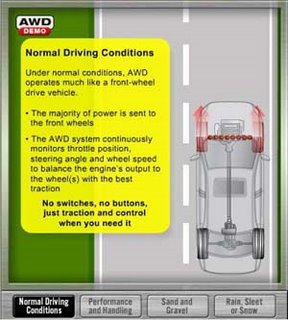
Ford all-wheel drive vs. four-wheel drive
With the addition of the all-wheel-drive (AWD) Ford Fusion and Mercury Milan, Ford Motor Company is now offering affordable AWD technology to a whole new group of customers, bringing it to one of the largest volume segments in the industry.
With the addition of the all-wheel-drive (AWD) Ford Fusion and Mercury Milan, Ford Motor Company is now offering affordable AWD technology to a whole new group of customers, bringing it to one of the largest volume segments in the industry.
Many of these new customers may wonder why they need AWD on their midsize sedan, especially if they live in a climate where the roads are never icy or snow covered.
“Many people think about the AWD system on the Ford Edge the same way they think of the four-wheel-drive (4WD) system on their F-150,” says Ashok Rodrigues, 4WD technical specialist for Ford Motor Company. “There’s been a lot of confusion in the industry as to how manufacturers use the terms 4WD and AWD.”
Rodrigues says there are three basic types of AWD/4WD systems, regardless of whether they’re based on front-drive or rear-drive vehicles. Those are part-time, center differential and on-demand.
Part-Time Four-Wheel Drive
Part-time systems are what most people commonly think of as 4WD. These rugged, traditional systems, found on trucks including the F-150 and Super Duty, feature a simple lock and unlock mechanism that locks the front wheels to the rear wheels. Four-wheel drive is engaged by the vehicle’s operator, usually by flipping a switch or pushing a button on the dash.
Part-time systems are almost always marketed with a low-range gear that’s used when maximum torque is needed, for such activities as extreme off-roading or for moving a heavy object.
“It’s pretty much a black or white operation,” says Rodrigues. “You either want four-wheel drive or you don’t.”
The benefits of this system are its ruggedness and the fact that it’s inexpensive. Four-wheel-drive vehicles are at their best pulling a boat out of the water or hauling a Bobcat back in the woods. The downside is that the system isn’t really adaptable to everyday driving.
“With a part-time system, you will inherently bind up when you go around corners,” says Rodrigues. “When cornering, the front wheels want to track a wider arc than the rear wheels. Because all four wheels are locked together physically, you simply can’t do that with part time. It is an inherent part of the design and is fully intended.”
Center Differential
The V-6 Mercury Mountaineer uses a center differential that constantly splits torque 40 percent to the front wheels and 60 percent to the rear wheels. Unlike the part-time system, the wheels themselves turn at different speeds, eliminating the binding that part-time systems exhibit when cornering.
Center differentials need some sort of clutch or limited-slip mechanism to control slip. For example, when the rear wheels begin to slip, the clutch mechanism applies brake torque to the rear axle, sending drive torque to the front axle and keeping the vehicle moving forward. Rodrigues says that traction control can also serve as the clutching mechanism, providing a cost-effective means of applying brakes to the spinning axle.
“The nice thing about a center differential is that it’s always sending that torque,” he says, “so you have a very nice refined driving performance. Some people really like those kinds of systems. But they can be heavy, expensive and, as the devices are generally purely mechanical, there simply aren't many tuning options.”
On-Demand All-Wheel Drive
The third type is the on-demand system. An on-demand system is always driving one axle and then drives the other axle as conditions demand. In the case of the Ford Fusion or Ford Edge, the front axle is the primary drive axle. For the Ford Explorer and Mercury Mountaineer, the rear axle is the primary drive axle.
Simple mechanical systems use a clutch to send torque to the secondary drive axle when the primary axle starts to slip. Today’s electronic systems — like those found on all Ford Motor Company cars as well as Ford Explorer and Expedition, the Lincoln Navigator and the V-8 Mercury Mountaineer — use a computer controller that monitors such things as steering angle, accelerator pedal position and engine speed to provide the precise amount of torque, front to rear, as needed.
“What’s really impressive about these systems is that they don’t just react to slip,” says Rodrigues. “They usually prevent that slip from occurring in the first place. By predicting slip and preventing it, the driver doesn’t feel the vehicle slipping and responding. The operation is seamless.”
He says on-demand systems create a smooth, confident driving feel in all weather conditions with much better traction. The systems also help balance and improve driving dynamics by sending torque to the secondary axle when it’s most appropriate for handling.
“On a normal front-drive vehicle, the front wheels have a limited amount of traction available to them,” says Rodrigues. “That traction has to be used for moving the car forward and for steering. If you use all of the torque to drive forward, you don’t have anything left to steer with, and vise versa. An AWD system off-loads some of that drive torque to the rear wheels. The harder you accelerate, the more of that torque that’s going to be redirected to the rear wheels, restoring the ability of the front wheels to steer the vehicle while providing an even higher level of acceleration.”
But he cautions that while these sophisticated AWD systems do help with acceleration, they won’t make the car stop any faster.
“Your traction is much better and your handling is much better,” says Rodrigues, “but AWD does not give you more braking power.”


No comments:
Post a Comment